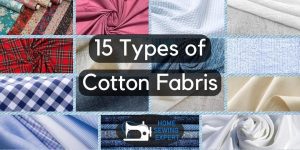Silk has been a popular fabric for hundreds of years because it is luxurious, long-lasting, and versatile. Everyone knows that silk feels expensive and soft and its surface is completely smooth. It is put together with natural fibers. You might not know that there are hundreds of different kinds of silk, though.
Due to their different properties, different kinds of silk are better for different things. The silk that comes from nature is both beautiful and useful. It is light and airy and drapes beautifully. A certain kind of silk can make everything from fancy window treatments to pajamas to bed sheets.
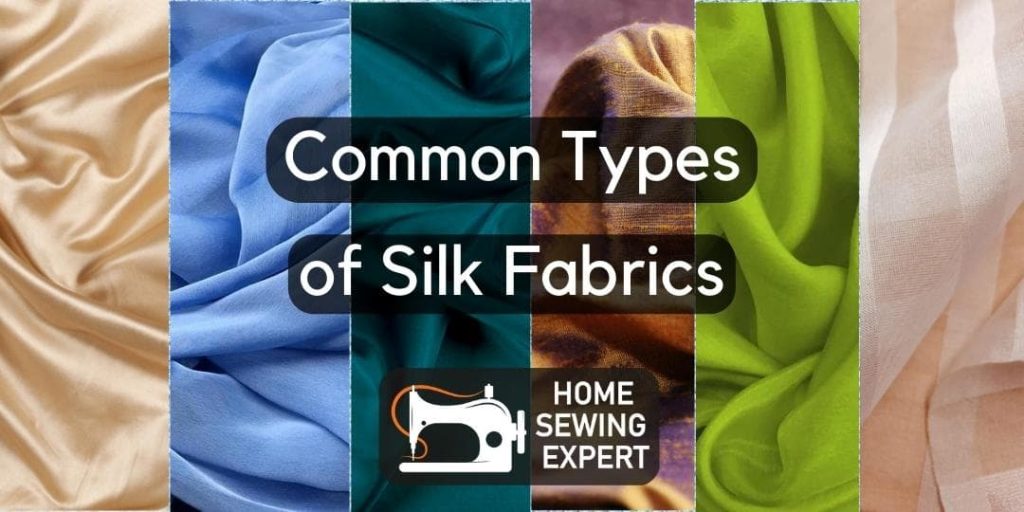
Synthetic silk vs. organic silk
The fight between synthetic and organic silk is about to start. If you win, the person who wins will give you the material for your scrunchie. Ready?
- Texture
The texture of natural silk could be better. It will always have flaws that show it was made by hand, while the smoothness and straightness of synthetic silk defy logic.
Silk is soft and flexible, so a quick and easy way to check its quality is to squeeze it tightly in your palm and see if it leaves creases. Even though such flaws are unlikely to be found in real silk, they will stand out very clearly in a fake fabric.
- Gloss
One sure way to spot synthetic silk is to look at how light moves through the fabric. Natural silk has a small sheen, and if you hold it up to the light, you might be able to see it sparkle. On the other hand, synthetic silk doesn’t shine and looks lifeless.
- You can feel what you touch.
A silkworm’s silk is always soft and smooth. The fabric has a texture that makes your hands feel like they are melting. Synthetic silk, on the other hand, feels and looks like any other fine fabric.
One of the best ways to straight tell if a fabric is a silk or polyester is by how it feels when heated or cooled. Real silk, however, warms up to the temperature of your skin right away, making it feel comfortable and natural.
- Cost
This is yet one of the clearest signs that something is not what it says it is. Because there is less of it and people want it so much, natural, high-quality silk can’t be sold for the same price as cotton or linen.
List of Different Types of Silk Fabric
The most well-known and often employed varieties of silk are listed below.
 Charmeuse
Charmeuse

Charmeuse is an airy, lightweight fabric that drapes beautifully. A satin weave is used in its construction. Because it, too, has a sparkly and dull side, charmeuse is sometimes mistaken for satin. When compared to cotton, charmeuse is shinier. The finest gowns, scarves, lingerie, and blouses can be crafted from charmeuse silk.
 Chiffon
Chiffon
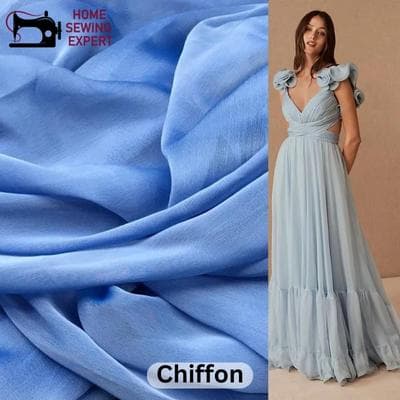
This is a lovely, lightweight fabric with a gauze-like texture and a lovely flow. Chiffon silk is incredibly delicate because it is woven from extremely tiny fibers. It can be stretched a little bit without affecting its shape.
Hence, chiffon overlays are commonly utilized to enhance the aesthetic of formal and bridal gowns. The fabric can also be fashioned into scarves, blouses, and shirts.
 Crêpe-de-chine
Crêpe-de-chine

Crêpe-de-chine is an ultra-sheer and delicate fabric characterized by a plain weave. Its crimped texture and muted sheen set it apart. Additionally, crêpe georgette and Moroccan crêpe exist.
Because of its lightweight and fluidity, crêpe-de-chine is commonly used for summer dresses, blouses, camisole tops, and lingerie.
 Dupion Silk
Dupion Silk
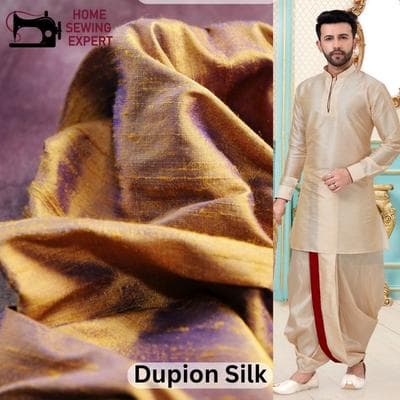
This is plain-weave silk tightly woven with two strands, giving it a crisp and textured appearance.
Strong, long-lasting, and lustrous fabrics employ varying sizes of weft and warp threads throughout the weaving process. If you look closely at the weaving, you might be able to spot a bit of the original cocoon from the silkworm.
 Habotai
Habotai
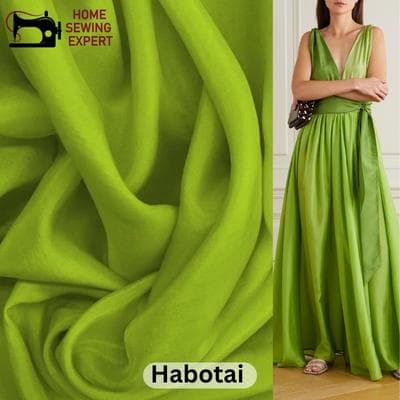
The plain-weave fabric habotai is extremely lightweight and comfortable to wear. A glossy, sleek surface is its hallmark. The traditional silk used for the lining is between 5mm and 8mm. It’s also great for making lingerie, summer tops, and scarves.
 Organza
Organza
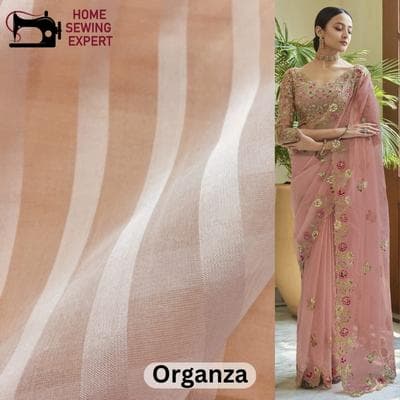
The fine, light, sheer organza is an open-weave fabric. It’s glossy and silky, too. Thin as it may seem, the material’s finely twisted threads ensure it will last.
Organza’s stiffness and crispness make it ideal for usage in these applications and on veils, collars, facings, and evening gowns.
Difference between satin and silk
Silk and satin look alike, so they often need to be corrected for each other. Silk is yet made from natural fibers, while satin is made from artificial fibers, but the two look very similar.
Silk
- Silk is a pure natural fabric made from the pure cocoons of silkworms. This might come as a huge surprise to you. When the cocoons are opened, the fibers can be taken out and spun into a thread in the textile industry. This fabric can make sheets, other bed linens, and even clothes.
- When held up to the right kind of light, silk looks shimmering. Its strength and durability come from the natural protein that silkworms make.
- Silk threads are made by hundreds of thousands of worms, which means that they require a lot of work and are more expensive because of this.
- Third, silk was first found in China a long time ago. This makes it the oldest fabric in the world. In the past, because it was a high-quality fabric, it was worn by people from wealthy families. It is now easy to find worldwide but usually costs more than common fabrics like cotton and satin.
Satin
- Cotton and wool are natural fibers that can be spun into yarn. But satin is an artificial fiber. Satin, nylon, polyester, or a mix of these materials could be used.
- Satin is more fragile than silk, so you must be careful. It doesn’t shimmer, but it still looks shiny. Satin has a flat, dull back because of how it is made. Both sides of the silk are as pretty as the other.
- If you wash satin in hot water, it can shrink by up to 20%. On the other hand, you shouldn’t do it if you don’t want it to shrink. Since this is the case, you must be careful when washing satin. Before cleaning a satin item, you should always check the care instructions. If the fabric is washed wrong, it may shrink or stretch. Some experts say that dry cleaning is the best way to clean satin.
- Third, you can wash silk, but you must do it by hand and cold water. Satin should never be cleaned with soap or bleach. Since dry cleaning is the only way to clean satin, keeping it in good shape costs more.
Frequently Asked Questions (FAQs)
How to tell if silk is real?
You can easily tell if your silk (or fake silk) is real with a few simple tests you can do at home.
- Hand-to-hand
You can feel how soft silk is just by touching it. When you touch real silk, it almost feels like wax. Also, if you squeeze it in your hand, it should make a crunching sound. Here are some signs that it’s not a fake.
- Ring testing
Use whatever you have to make rings for your fabric. You can gently pull the silk into the middle of the ring to see what happens. Synthetic fibers tend to get caught on the ring or bunch up, while real silk should go through it easily.
- Burning test
It’s a good way to dye silk if you’re willing to risk ruining the whole thing, but the result is hard to beat. If you trust your nose and burn a small piece of your fabric with a lighter, you can tell the difference between real silk and fake silk.
How to get a stain out of silk?
What could be worse than getting lipstick on your expensive blouse? What would you do if they shrunk when you dried half of your silk clothes? You can avoid many wardrobe mishaps if you don’t use this delicate fabric. Silk is pretty easy to clean, believe it or not.
Once a stain is found on a piece of silk that was once clean and shiny, it may seem impossible to get rid of it. Please don’t give up yet; it’s too early. If you get something on silk and want to get it out, you can try a few different things.
- Getting rid of a stain should be done as soon as possible. When a stain has dried, it is much harder to get rid of.
- Second, gently wipe the stained area with a paper towel or clean cotton wool to remove as much of the stain as possible.
- Third, to make a mild cleaner for silk, mix a few drops of the cleaner with a tablespoon or two of white vinegar or lemon juice and a tablespoon or two of lukewarm water.
- Start with a small, unnoticeable piece of silk to test the solution. Then, use a clean, white cloth to dab the solution on the stain. Don’t pick at the wound.
If you follow these steps, cleaning silk should be easy in a hurry. If you take care of your clothes, you won’t ever have to buy new ones because of lipstick, coffee, or shrunken blouses.
What is cotton silk?
Cotton silk fabric is made from both silk and cotton. A single fabric is made by putting the best parts of both fabrics together. The fabric, made from a mix of cotton and silk, is soft, strong, light, and breathable.
Cotton silk sarees are just as high-quality as their more traditional counterparts, and their eye-catching patterns and designs have made them a fashion staple in recent years.
Silk is made only from natural fibers, so it contains no chemicals. Silk fiber looks so much like hair that it’s easy to think it’s hair. It’s mostly protein (97%), with only a little bit of fat (3%) and wax (3%). It also has 18 amino acids that are good for the skin, which is a bonus.
If you have allergies, silk is the fabric you should consider wearing. So, dust mites and things that cause allergies, like dust, mold, or fungus, don’t like it.
Silk’s anti-aging and skin-soothing effects come from its ability to keep moisture in the skin. This is possible because the product can keep the skin’s moisture.
What is spider silk?
People can think of spiders in many different ways. One of them has to be that spiders build webs. Spiders make their webs out of something called “spider silk.”
Proteins are used to make the threads of spider silk. Most of the time, a single spider will make more than one kind of silk.
Some spider species use one type of silk to make the webs that catch their food. And they use a different type of silk to wrap up their food once they have caught it. One type of spider that doesn’t make webs is the jumping spider. Instead, they make tiny homes out of silk.
Scientists plan to use the silk in many ways once they figure out how to make it. Some of the things that have been suggested are:
1. Fake skin for people who have been burned
2. Second, ligaments made of plastic
3. Three kinds of bandages help you heal faster.
4. Surgical stitches, also called sutures, are used to fix wounds.
5. Airbags in cars that have less force
6. Clothes or body armor that can stop bullets
7. Nets, ropes, and a parachute make seven.
Because spider silk is so strong, it can be hard to get out of a web after you’ve walked through it. Spider silk has more than once been called “stronger than steel.” It may not be as strong as steel, but it’s surprisingly strong for its fragile appearance.
How strong is spider silk?
You have probably heard that spider silk is as strong as steel. This is amazing for something made by such a small animal. It might be true, but it’s not the whole story.
Strength can be gauged through a variety of means. Phys.org reports that the tensile strength of spider silk is yet comparable to that of steel. A material’s tensile strength indicates how much tension it can withstand before snapping.
Tensile strength is yet measured in force per unit area (GPA). Some spider silks have a tensile strength of roughly 1 GPa, whereas steel has a tensile strength of between 0.2 and 2 GPa.
Is mulberry silk real silk?
Silkworms make mulberry silk, which is one kind of silk. People know that the cloth looks and feels very nice. Mulberry silk comes from the silkworms of the Bombyx Mori moth. When silkworms eat the leaves of the White Mulberry tree, they make high-quality silk that is white.
Most people like this material because it has these advantages:
Mulberry silk is good for the environment, just one of its many benefits. Silkworms only get their food from the leaves of the mulberry tree, which take in CO2 from the air and store it.
Raw mulberry silk is completely natural and biodegradable, unlike synthetic materials. However, this can be changed by the colors or chemicals used in the manufacturing process.
Mulberry silk is a strong fabric that can last a long time and take a lot of wear and tear. • Pure Mulberry Silk is so soft and smooth that sleeping on it helps you sleep better. Because of this, many luxury hotel suites come with mulberry silk sheets.
Because it is silky, you don’t have to worry about it breaking when you use it as a pillowcase or a hair accessory.
Mulberry silk is a great choice for people who tend to get too hot at night or live in places with a lot of humidity because it can wick away moisture.
Conclusion
Silk is a type of fabric that comes in many different styles. It can be used in more ways than any other product on the market. It is the only material used to make a wide range of beautiful, breathable, and useful fabrics.
Silk can be used to make a wide range of things. This can be from everyday clothes to formal wear, pajamas, cozy scarves, window treatments, pillows, and even mattresses. For the right price, silk can add a touch of luxury to many parts of your life.

Hello, My name is Malinda Spicer. in my 10th grade, my granny gifted me a mechanical sewing machine. Since then, my whole life revolves around sewing. I made my hobby into a profession by getting a professional degree in fashion designing. I had learned quite well about sewing in the past 20 years. I hope to be of help by sharing these experiences and expert advice with my fellow sewers.

